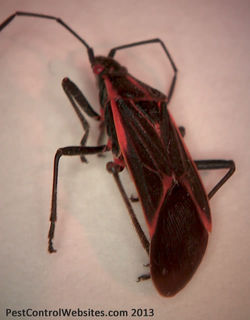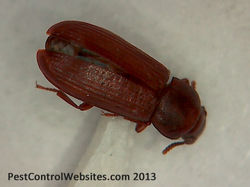 |  |  |
|---|---|---|
 |  |  |
 |  |  |
Guide to Occasional Invaders

Boxelder Bug
Boisea Trivittata
Description: Boxelder Bugs commonly congregate alongside homes or trees near female Boxelder Maple Trees and in full view of the sun. They are identifiable by the distinct black and red coloring on their bodies (the red appearing as stripes against the black). TIP: Boxelder Bugs will secrete a staining dye when crushed. If found indoors, your best bet is to remove them with a paper towel or vacuum cleaner to avoid a mess.
Color: Black and Red
Legs: 6
Shape: Oval
Size: 1/2"
Antennae: True
Habitat: Outdoors near Boxelder Maple trees
Threats: None
Prevention: Seal cracks in foundation, windows, and doors.

Centipedes
Chilopoda and Diplopoda
Description: Centipedes are arthropods belonging to the class Chilopoda of the subphylum Myriapoda. They are elongated metameric animals with one pair of legs per body segment. Despite the name, centipedes can have a varying number of legs from under 20 to over 300. Centipedes can easily be distinguished from millipedes by counting the number of pairs of legs arising from most body segments: millipedes have two pairs, while centipedes bear one pair per segment, with the first pair of legs being modified into fangs.
Color: Varies. The majority are brownish or orange-brown.
Legs: 20-300
Shape: Centipedes are generally flattened and have a pair of well developed antennae on the head. Some centipedes, such as the House Centipede (Scutigera coleoptrata Linnaeus), have long legs and are capable of running rapidly.
Size: 1½" - 4"
Antennae: True
Habitat: Centipedes are frequently found around buildings.
Threats: None
Prevention: Seal cracks in foundation, windows, and doors. Reduce the amount of leaves and mulch near your home.

Earwigs
Order Dermaptera
Description: Earwigs got their name from the myth that they crawl into sleeping people's ears and tunnel into their brains. The long cerci, or clippers, on their backsides easily identify an earwig.
Color: Dark Brown
Legs: 6
Shape: Long, Narrow
Size: 1"
Antennae: True
Habits: Earwigs hide during the day and feeds on leaves, flowers, fruits, mold and insects at night.
Habitat: These insects live together outdoors in large numbers. They can be found under piles of lawn debris, mulch or in tree holes. They gain entry to a structure through exterior cracks
Threats: Contrary to folklore, earwigs do not crawl into ears and eat peoples' brains at night. They do not spread diseases, but their menacing appearance can be alarming to a homeowner.
Prevention: Remove harborage sites such as leaf piles, mulch piles or other vegetation. Seal cracks and crevices well to prevent structural entry.

Flour Beetle
Tribolium Confusum
Description: The Flour Beetle enjoys wheat and other grains and are adapted to survive in very dry environments. They have a voracious appetite for stored cereals and nuts, annually causing millions of dollars in damage.
Color: Reddish Brown
Legs: 6
Shape: Oval
Size: 1/8"
Antennae: True
Region: Red Flour Beetles are found more often in southern states. The Confused Flour Beetle is found in northern states.
Habits: Red Flour Beetles fly and can invade via an outside food source.
Habitat: They are common in processed grain. Their flattened body allows them to make their way into almost any package. Flour and other processed foods heavily infested by these beetles often develop a gray tint.
Threats: They are a major pest in the agricultural industry and are highly resistant to insecticides.
Prevention: Food products need to be inspected for signs of infestation, including cereals, and packaged dried foods.

Lady Bug
Coccinellids
Description: A few species of Lady Bugs are considered pests in North America and Europe, but they are generally considered useful insects as many species feed on aphids or scale insects, which are pests in gardens, agricultural fields, orchards, and similar places. Harmonia Axyridis (or the Harlequin Ladybug) was introduced into North America from Asia in 1988 to control Aphids but is now the most common species as it is out-competing many of the native species.
Color: Black and Red
Legs: 6
Shape: Oval
Size: 1 mm to 10 mm (0.04 to 0.4 inches)
Antennae: True
Habitat: Predatory Lady Bugs are usually found on plants where Aphids or scale insects are, and they lay their eggs near their prey, to increase the likelihood the larvae will find the prey easily. Lady Bugs are cosmopolitan in distribution, as are their prey.
Threats: None
Prevention: Seal cracks in foundation, windows, and doors.

Millipedes
Oxidus Gracilis
Description: Millipedes are arthropods that have two pairs of legs per segment (except for the first segment behind the head which does not have any appendages at all, and the next few which only have one pair of legs). Each segment that has two pairs of legs is a result of two single segments fused together as one. Most Millipedes have very elongated cylindrical bodies, although some are flattened dorso-ventrally, while Pill Millipedes are shorter and can roll into a ball, like a Pill Bug. The millipede's most obvious feature is its large number of legs. Having very many short legs makes millipedes rather slow, but they are powerful burrowers.
Color: Black and Red
Legs: 99
Shape: The head of a millipede is typically rounded above and flattened below and bears large mandibles. The body is flattened or cylindrical, with a single chitinous plate above, one at each side, and two or three on the underside.
Size: 2 - 280 millimetres (0.079 to 11") in length
Antennae: True
Habitat: Millipedes live outdoors and are commonly found in leaf litter, landscape mulch, lawns, and under items in contact with the ground. If indoors, they may survive in moist areas of garages, crawl spaces, and basements.
Threats: None
Prevention: Seal cracks in foundation, windows, and doors. Reduce the amount of leaves and mulch near your home.

Pill Bugs
Armadillilium Vulgare
Description: Pill Bugs are the only crustacean that has become completely adapted to spending its life on land. Pill Bugs have oval bodies and seven pairs of legs. They are easily recognized by their back, which is made up of seven hard individual plates. Pill Bugs are sometimes referred to as rollie-pollies.
Color: Dark brown to black
Shape: Oval; round when rolled up
Size: 3/4"
Antennae: True
Habits: Pill Bugs eat decaying vegetable material and are most active at night. They are known for their ability to roll into a ball.
Habitat: Pill Bugs live in moist locations. They are found under damp objects or under vegetable debris.
Threats: Pill Bugs do not spread diseases or invade food products. However, the pill bug is often considered a pest when it gains entry into a home.
Prevention: Pill Bugs can be avoided by eliminating food sources such as vegetable or plant debris. If Pill Bugs enter a structure, they will often dry out and die.

Stink Bugs
Halyomorpha Halys
Description: The Stink Bug is notorious for its “smelly” reputation. It earned its name from its tendency to release an odor when disturbed or when crushed. Many other insects have these same characteristics, including some species of ants, beetles and other bugs. Most stink bugs are herbivorous and use their piercing and sucking mouthparts to feed on plant juices. A few common species of stink bugs are predatory and use their mouthparts to drain fluids from caterpillars and other pest insects.
Color: Brown, Gray of Dark Green
Legs: 6
Shape: Oval
Size: 3/4"
Antennae: True
Habits: Most species of Stink Bugs are innocuous, only feeding on their host plants, and are seldom encountered by humans. Stink Bugs feed on a variety of plants, including crop species. When Stink Bugs feed on tree fruits such as apples, it results in a characteristic distortion, referred to as “cat facing,” that renders the fruit unmarketable. Some species can cause damage in cotton and other crops. Predatory Stink Bugs use their mouthparts to drain fluids from other pest insects. Some predatory Stink Bugs are important, beneficial insects in crops and gardens. They prevent caterpillars and other insect pests from destroying plants, trees, crops and gardens. Scientists are interested in using them as natural control agents of crop pests. When handled or disturbed, Stink Bugs are able to secrete a bad-smelling, bad-tasting fluid from pores on the sides of their bodies. This secretion protects Stink Bugs from predators. They are often fed upon by birds, spiders, assassin bugs and other arthropod predators (including other Stink Bugs). Many species are attracted to lights at night. Adult Stink Bugs of various species are active from spring through late fall.
Habitat: During warm months, female Stink Bugs attach large masses of eggs to the underside of leaves and stems. After hatching, the wingless nymphs go through five immature stages before becoming full-sized, winged adults.
Threat: Stink Bugs are not known to bite humans but caution should be used when handling them to avoid a release of their odor.
Prevention: To prevent Stink Bugs from entering homes and buildings, seal cracks around windows, doors, siding, utility pipes, behind chimneys, and underneath the wood fascia and other openings. Use a good quality silicone or silicone-latex caulk. Damaged screens on doors and windows should be repaired or replaced. A licensed pest professional can treat for Stink Bugs in the late summer or fall just prior to bug congregation. If Stink Bugs have already entered a home or building, a vacuum cleaner can aid in the removal of live or dead Stink Bugs. The bag must be removed to prevent odor from permeating the area. If an infestation has developed inside the home or building, a licensed pest control operator should be called to evaluate and assess the problem.

Weevil
Lixus Angustatus
Description: A Weevil is any beetle from the Curculionoidea superfamily. They are usually small, less than 6 millimetres (0.24 in), and herbivorous. There are over 60,000 species in several families, mostly in the family Curculionidae (the true Weevils). Some other beetles, although not closely related, bear the name "weevil", such as the Biscuit Weevil (Stegobium Paniceum), which belongs to the family Anobiidae. Many Weevils are damaging to crops. The grain or Wheat Weevil (Sitophilus Granarius) damages stored grain. The Boll Weevil (Anthonomus Grandis) attacks cotton crops. It lays its eggs inside cotton bolls, and the young Weevils eat their way out.
Color: Brown, Gray, Black
Legs: 6
Shape: Oval
Size: 1/8"
Antennae: True
Habitat: Weevils are often found in dry foods including nuts and seeds, cereal and grain products, such as pancake mix. In the domestic setting, they are most likely to be observed when a bag of flour is opened.
Threats: They are a major pest in the agricultural industry and are highly resistant to insecticides.
Prevention: Food products need to be inspected for signs of infestation, including cereals, and packaged dried foods.

